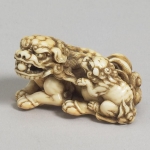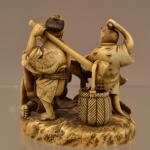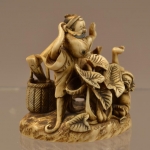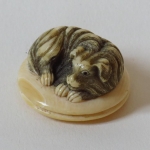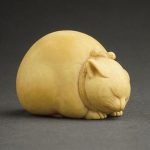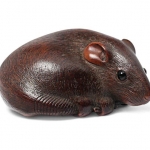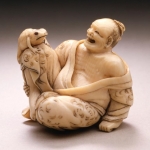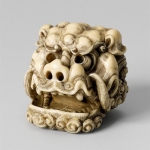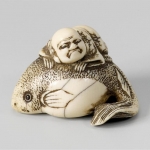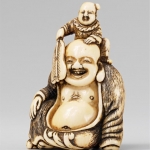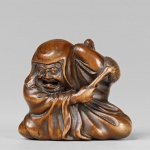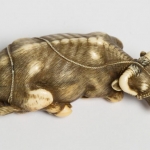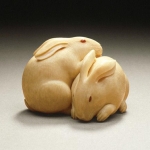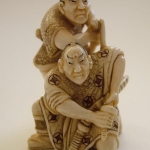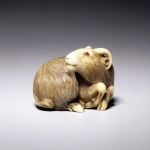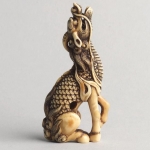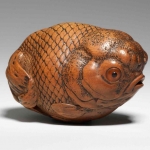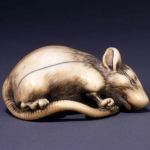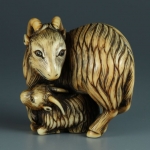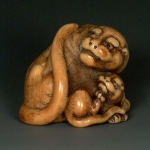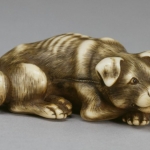Netsuke
Netsuke were invented out of the necessity of preventing items that were hung on the person and carried, such as inro (a pillbox), yatate (a portable writing set), cigarette cases and pouches from being lost or stolen. People would hang items from their obi (sash) with a string and attach a netsuke to the other end of the string as a fastener. Materials such as animal bones, including ivory and bull horns, ceramic and metals were used to make netsuke and they were finely sculptured by Japanese craftspersons.
The Kyoto Seishu Netsuke Art Museum is located in Mibu, which used to be the western end of the capital of Kyoto during the Middle Ages. The area is also known for being home to the Mibu Goshi, who were samurai warriors that became farmers during the Edo period (1603-1867). The museum building is believed to have been built as the residence of the Kanzaki Family, one of the Mibu Goshi, in 1820. The residence of the Kanzaki Family was designated by Kyoto City as a tangible cultural property. We intend to contribute toward the development of culture by preserving this historic architecture and imparting the cultural value to posterity.
Netsuke — small, finely carved figures in ivory, wood, bone, lacquer, metal and porcelain— came into wide use as toggles for money purses, tobacco pouches, etc. in the Edo period (1600-1868). They remained popular, almost exclusively for men, until the beginning of the 20th century when traditional Japanese clothing for men went out of style.
For the past 100 years netsuke have become popular with collectors all over the world. They originally caught the attention of art collectors in Europe. Today, they have become widely appreciated internationally as both art objects and as valuable antiques. Old originals are very hard to find nowadays, and can be quite expensive. However, high quality reproductions in horn and bone are widely available in Kyoto’s antique shops. Netsuke carving is a very precise craft form and takes a single craftsman a long time to finish.
What is a netsuke? (pronounced “nets-keh”)
A netsuke is a small sculptural object which has gradually developed in Japan over a period of more than three hundred years. Netsuke (singular and plural) initially served both functional and aesthetic purposes. The traditional form of Japanese dress, the kimono, had no pockets. Women would tuck small personal items into their sleeves, but men suspended their tobacco pouches, pipes, purses, writing implements, and other items of daily use on a silk cord passed behind their obi (sash). These hanging objects are called sagemono. The netsuke was attached to the other end of the cord preventing the cord from slipping through the obi. A sliding bead (ojime) was strung on the cord between the netsuke and the sagemono to allow the opening and closing of the sagemono.
The entire ensemble was then worn, at the waist, and functioned as a sort of removable external pocket. All three objects (netsuke, ojime and the different types of sagemono) were often beautifully decorated with elaborate carving, 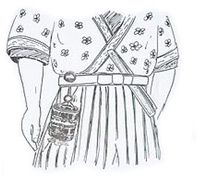 lacquer work, or inlays of rare and exotic materials. Subjects portrayed in netsuke include naturally found objects, plants and animals, legends and legendary heroes, myths and mystical beasts, gods and religious symbols, daily activities, and myriad other themes. Many netsuke are believed to have been talismans. These items eventually developed into highly coveted and collectible art forms. Today we see a broad range from “folk art” carvings to levels of sophistication some consider to be fine art.
lacquer work, or inlays of rare and exotic materials. Subjects portrayed in netsuke include naturally found objects, plants and animals, legends and legendary heroes, myths and mystical beasts, gods and religious symbols, daily activities, and myriad other themes. Many netsuke are believed to have been talismans. These items eventually developed into highly coveted and collectible art forms. Today we see a broad range from “folk art” carvings to levels of sophistication some consider to be fine art.
With transition to European dress, the use of sagemono and netsuke declined, nearly disappearing over the period from the end of 19th to the first quarter of the 20th century but the production of netsuke did not completely go away. Instead, under a strong influence of Western collectors visiting Japan in larger and larger numbers, netsuke developed into a form of fine art and exists as such today with true master-carvers from all over the world still creating these little masterpieces. Unfortunately, the souvenir industry both in Japan and abroad stimulated production of low artistic value mass-produced figurines mimicking the real netsuke to satisfy the growing tourist demand. Those netsuke-like objects should not be confused with the authentic art pieces regardless of their age and origin.
Are there different types of netsuke?
Yes, with the most common being the katabori or figural netsuke. Manju netsuke are named after a popular bean paste confection that came in a round, flat shape. Kagamibuta (literally, “mirror lid”) are a special type of netsuke with a metal lid and a bowl, usually of wood or ivory. Mask netsuke, were carved as miniature versions of the masks used in Noh and Kyogen plays. There are also sashi or long, thin netsuke, that were thrust through the belt, with the sagemono suspended from the end that protrudes from the obi
Types of Netsuke
Katabori Netsuke
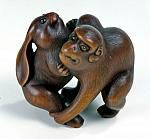
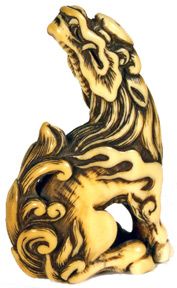
Examples of katabori netsuke
Kataborinetsuke or “sculpture netsuke” is the most common type of netsuke. They are compact three-dimensional figures carved “in the round”, and are generally about one to three inches high.
Anabori Netsuke
 Anabori netsuke or “hollowed netsuke” – a subset of katabori which are carved out for a hollow center. Clams are most commonly the motifs for this type of netsuke. Elaborate scenes may comprise the interior.
Anabori netsuke or “hollowed netsuke” – a subset of katabori which are carved out for a hollow center. Clams are most commonly the motifs for this type of netsuke. Elaborate scenes may comprise the interior.
Manju Netsuke
Manju netsuke or “manju netsuke“- a thick, flat, round netsuke, with carving usually done in relief, sometimes made of two ivory halves. Shaped like a manju, a Japanese confection.
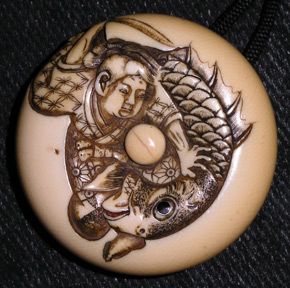
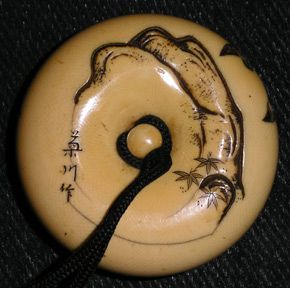
Front and back of a manju netsuke
Ryusa Netsuke
Ryusa netsuke – shaped like a manju, but carved like lace, so that light is transmitted through the item.
Kagamibuta Netsuke
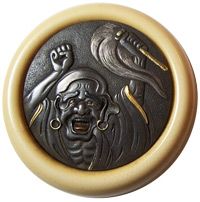 Kagamibuta netsuke or “mirror lid netsuke” – shaped like a manju, but with a metal disc serving as lid to a shallow bowl, usually of ivory or sometimes wood. The lid is often highly decorated with a wide variety of metallurgical techniques.
Kagamibuta netsuke or “mirror lid netsuke” – shaped like a manju, but with a metal disc serving as lid to a shallow bowl, usually of ivory or sometimes wood. The lid is often highly decorated with a wide variety of metallurgical techniques.
Obi-hasami Sashi Netsuke
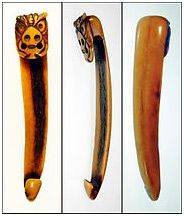
Sashi netsuke – an elongated form of katabori, literally “stab” netsuke, similar in length to the sticks and gourds used as improvised netsuke before carved pieces were produced. They are about six inches long.
Obi-hasami – another elongated netsuke with a curved top and bottom. It sits behind the obi with the hooked ends visible above and below the sash.
Mask Netsuke
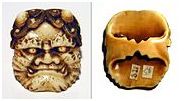 Mennetsuke or “mask netsuke” – the largest category after katabori, these were often imitations of full size Noh, Bugaku or Kyogen masks, and share characteristics in common with both katabori and manju/kagamibuta.
Mennetsuke or “mask netsuke” – the largest category after katabori, these were often imitations of full size Noh, Bugaku or Kyogen masks, and share characteristics in common with both katabori and manju/kagamibuta.
Trick Netsuke 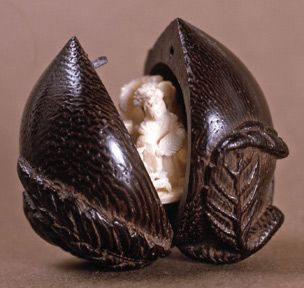
Karakuri netsuke or “trick/mechanism netsuke” – any netsuke that has moving parts or hidden surprises.
Aren’t all netsuke made from ivory?
No, that is a common fallacy. Perhaps only half of all netsuke are ivory. Netsuke-shi (netsuke carvers) used the materials that were available. Mainly artists located in Osaka, Kyoto, and Edo (Tokyo) had access to ivory in the old days. Artists outside of these population centers primarily used box or cherry wood, which they stained and polished. However, nearly every material imaginable was used, including almost 100 types of wood, killer whale teeth, narwhal and walrus tusk (marine ivory), boar’s tusk, amber, stag antler, pottery, bamboo, coral, and more.
Are all netsuke signed?
No, there are many unsigned netsuke. In fact, some of the netsuke considered by many experts to be among the greatest are unsigned. Among them are the netsuke frequently referred to as the Meinertzhagen Kirin after its first official Western owner, and a famous ivory netsuke depicting an Ama (Japanese diving girl) and a squid. Some collectors prefer unsigned works, since they avoid the controversy of whether the work is by a famous artist, a pupil or later follower of that artist, or just a copy.
Where can I see netsuke?
A number of Museums around the world have netsuke collections. Some of the finest collections can be viewed in the Los Angeles County Museum of Art (LACMA), Museum of Fine Arts in Boston, National Art Museum in Tokyo, British Museum and Victoria and Albert Museums in London.
In the United States, the LACMA has a permanent exhibition of 150 netsuke from the Raymond and Frances Bushel collection. There are a total of 600 netsuke in the collection, which are regularly rotated into the exhibition.
The British Museum in London also has a permanent exhibition of netsuke from the A. H. Grundy collection.
Many other museums, including the Metropolitan Museum in New York, the Louvre in Paris, the Hermitage in St. Petersburg, have netsuke collections but they usually exhibit just a few at a time.
Unfortunately, due to the small size of netsuke, their display for public viewing is always a challenge so is not done often. Also, due to a relatively late recognition of netsuke as an art form, most of the museum collections were formed based on a number of previously assembled prominent private collections of the time, and therefore may be limited in size and scope by the personal tastes of the original owners.
Some believe the best netsuke masterpieces are still in private collections. Fortunately, some of those major collections are periodically made available for viewing and handling to the INS members by their generous owners. Also, due to the significant number of netsuke periodically changing owners through major art auctions, such as Bonham’s, Christie’s and in the past Sotheby’s, a large number of images with corresponding sales prices can be accessed through their electronic archives.
In the United States, the Los Angeles County Museum of Art has a permanent exhibition of 150 netsuke from the Raymond and Frances Bushell collection. There are a total of 600 netsuke in the collection, which are regularly rotated into the exhibition. Numerous United States museums have netsuke collections, but they usually exhibit just a few at a time. The British Museum in London also has a permanent exhibition of netsuke from the A.H. Grundy collection.
What are the best books on netsuke?
Today there is a wealth of good books, with beautiful illustrations, on netsuke. Two good works for beginners, both by Raymond Bushell, are An Introduction to Netsuke and The Wonderful World of Netsuke. Two volumes, which provide a comprehensive look at netsuke, are Netsuke by Neil K. Davey and Collectors’ Netsuke also by Bushell. Raymond Bushell has also adapted the most basic work in Japanese on netsuke, The Netsuke Handbook of Ueda Reikichi. Finally, for those collectors interested in reading signatures, there is Netsuke and Inro Artists and How to Read their Signatures by George Lazarnick. Serious collectors always have extensive libraries which also include catalogs of special exhibitions of dealers, museums, and auctions. The Forum on this INS website also includes book recommendations as a dedicated topic which is added to periodically.
Where can I buy books on netsuke?
Three Asian art book dealers have Web sites. They are Paragon Book Gallery Ltd., Han-Shan Tang Books, and Rare Oriental Book Company.
Where can I buy netsuke?
Art Dealers: A special group of Asian art and antiques dealers who focus especially on netsuke and sagemono are among the members of the International Netsuke Society. Many of them exhibit at the International Netsuke Society Conventions.
Auctions: Two of the world’s largest auction houses, Christie’s and Bonhams have regular Japanese art auctions, often featuring netsuke, in London, New York, and San Francisco. There are also a variety of smaller auction houses in the United States and Europe that have Asian art auctions, many with netsuke, at least once a year.
Are there fake netsuke?
Due to the collectability of netsuke there are many fakes (or “netsuke-like carvings”) available in the marketplace. Many of these objects can clearly be seen as modern mass produced items to the trained eye while others are more difficult to discern as fakes. Crude modern copies, frequently referred to as “Hong Kong” netsuke, either in ivory or plastic, can be sold for as much as a few hundred dollars in souvenir shops and antique malls. There are also good modern copies of 18th and 19th century works, meant to defraud and sold for thousands of dollars. Finally, there are 19th century copies of earlier works that were carved by the Japanese to meet the demand from European collectors. These are excellent works of art but the difference in value between these copies and the original items can be a factor of ten or more.
Low quality tourist type netsuke, better referred to as netsuke-like carvings, frequently have meaningless squiggles carved to appear as legitimate signatures or a Japanese sounding name dictated by the factory where produced. Some of these carvings actually use poor reproductions of famous artists’ mei (signatures) in an attempt to enhance their worth.
Often an art expert evaluation is required to recognize the difference between the best fakes and authentic pieces. As a result, we recommend that new collectors learn from auction houses and dealers who are experienced in handling netsuke. The Forum of this website is also a great place to start one’s education, along with the acquisition of a few good books. Joining the International Netsuke Society allows a person to attend conventions and also interact with other collectors on a local basis for hands-on discussion with some of the world’s top authorities.
Don’t the Japanese own all the great netsuke?
No, in fact most of the current greatest collections are outside of Japan. Netsuke were exported from Japan in large numbers starting in the last quarter of the 19th century. With the Meiji restoration in 1868, western dress was adopted in Japan and netsuke lost their raison d’être. Very large collections were built in England, France, and the United States. Today, many of the best collections are still in Europe and the United States either in private hands or museums.
What factors are involved when buying netsuke?
Authenticity
Determining authenticity is not that easy. The signature may be the easiest part of the whole carving to be faked, but even signs of age were successfully faked by some carvers at all times. As with most other art forms, all it takes to determine authenticity is to be able to accurately identify and match the age, the style, the school, the signature, the material, even the stroke and the artistry of different netsuke. This takes years of thorough studying and of handling of thousands of authentic netsuke to master.
Artistry/Skill of the Artist
Viewing a large number of netsuke shows us a broad range of skills of the artists who produced them. From the simplest “folk art” works to the Michelangelo’s of the netsuke world we see every level of talent. Some collectors look for those artists who made very simple carvings, others complex and minutely detailed. One can find beauty in both and the skill a particular carver brings to either end of this spectrum is always open to debate. However, advanced collectors usually agree at least on the relative merits of a carving.
Condition
There is a good deal of disagreement about the importance of wear, chips, age cracks and restoration. There is no doubt that damage affects the value of a netsuke, but the extent of this depends on age and rarity, among other factors. Netsuke are expected to show some sign of wear but the wear on a netsuke should not be so far advanced as to devalue the piece. Most collectors will agree that cracks, minor chips, surface erosions, tiny repairs, and similar small defects are acceptable in direct relationship to the age of the netsuke.
Specific Artists/Schools of Carvers
The names Tomotada, Okatomo, Toyomasa, Tomiharu, Kaigyokusai, Kokusai, and Morita Soko are familiar to collectors and are highly sought after artists. Pupils of these top artists, their “schools” of followers, and subsequent carvers who worked in their style may be collected by those who cannot afford top level pieces. Seasoned collectors can differentiate styles/locales of netsuke production such as Kyoto, Osaka, Asakusa, Tokyo, Iwami, Hida and others. They may even “attribute” a specific netsuke to a well-known artist.
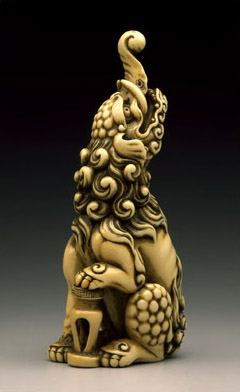
Baku
18th century, Ivory
Rarity/Subject
Some subjects are infrequently encountered in netsuke and therefore more desirable. Such is the case with the mythical beast called a baku (which eats bad dreams). Others, such as the squirrel, even though not seen often don’t seem to draw the same level of interest. Some collectors specialize by collecting animals, legends, or mythical subjects, etc. They may be willing to pay more to fill a void in their collection or acquire a fine example of a subject they appreciate.
Price
Prices of netsuke vary greatly from a few hundred to hundreds of thousands of U.S. dollars. Top prices are frequently connected to a few well known artists. As with most other art objects, the value of a particular netsuke is based on a combination of intrinsic and extrinsic factors. In general the existence of a signature, unless proven to be authentic to a handful of the most famous master-carvers, does not have much influence on the value. Nor does the material. What matters most is the quality of carving, originality, rarity, and its artistic appeal. In the end beauty is in the eye of the beholder and when two willing buyers come together in the auction room sometimes the sky is the limit.


